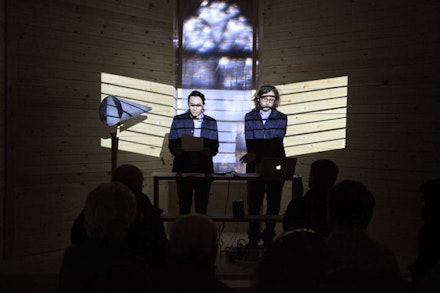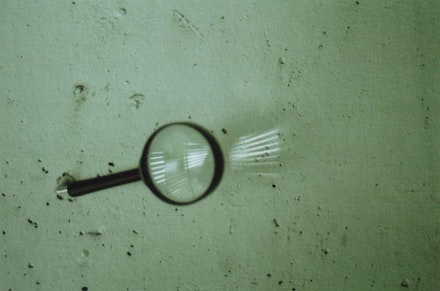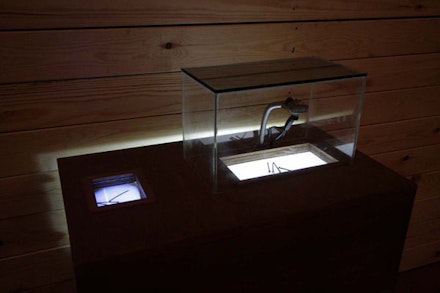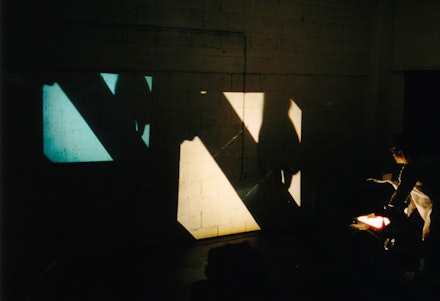Sala-manca (Lea Mauas and Diego Rotman) is a group of Argentinean-born visual and performance artists, publishers, and curators. The group is based in Jerusalem. Since 2000 Sala-manca has presented its works in major stage and gallery venues in Israel and abroad, including at the Tel Aviv Center for Contemporary Art, Holon Center for Digital Art, Tate Modern in London, Black Box in Belfast, Dox in Prague, Eyebeam in New York, Ujazdowski Castle in Warsaw, and more. In 2009 Sala-manca initiated the art and media center “Mamuta,” which is currently located at the former Lepper’s Home in Jerusalem (Hansen House). sala-manca.net
If a rose is a rose according to Gertrude Stein, and a tool is a tool, we can not but reconsider the old Borgean statement that all the Niles are in the word “Nile” and all the tools are in the word “tool.” The tools in our practice constitute a constructed meaning. The tool is thus not only a tool but it is also a rose. In many of our works there is a direct reference to the “tool” itself, mentioned literally in the text of a performance, in the title, or exposed visually as a self-reflexive act of recognition of the cultural (sometimes even political) and technological implications of its use.

The relevance of a specific tool, or the accurate use of it, is related to each specific project we carry out: a tool may be an overhead projector if we work with eggs or toilet paper; an Arduino microcontroller if we perform interactive work with the landscape; an idea or a concept; or the creation of a real institution like the Mamuta Art and Media Center or a fictional-real institution like the Museum of the Contemporary. The tool is an aesthetic definition, an economic statement, a political position. A Bedouin booth became a tool used to construct a specific Jewish booth (sukkah) for the Festival of the Tabernacles (Sukkoth), which due to the tool used underwent a change in meaning and context. A tool in the traditional definition of tool is: “Any physical item that can be used to achieve a goal, especially if the item is not consumed in the process.” (Wikipedia)

The tool may be the message, as in the case of our work-video, currently underway: “To Live her Life,” (2002) in which the tool (the video camera) is filming Dreyer’s “Jean d’Arc” in Godard’s film To Live her Life (1962), with an exaggerated zoom-in that blurs the borders of the media, making the quotation marks disappear. The video camera is not only the tool but also the reference to the media itself in relation to the history of cinema.


Our body too may be a tool. A performance can become a tool. We, as guards of our own museum, have become tools performing the infrastructure of an Art Museum. The museum is our tool. A tool may be a work of art. In an exhibition at the Digital Art Lab in Holon, we reproduce one of the columns that supports the art center. An axis mundi can thus be a tool. The voice, the body, the silence, the shade, the light, the money—all can become tools. When we exhibited the entire budget of the project as an installation, as the project itself, the money became both the tool and the art work, referencing an ultimate tool in the arts. When we named one of our alter-ego artists Marianne Loop, who curated the show Real Time in the Age of Lie (2004), we made it from the mythical 20th-century tool of a Romanian sound artist, or from a Romanian sound artist—a tool. When we told the story of the actor who hanged himself in the theater, from the word “mimesis,” the word became the tool that can kill.
Silence is a tool. A cake, an overhead projector, PowerPoint software, an H.D. or S.D. video camera, a slide, a recording tape machine, digital recording software, an Arduino microcontroller, an LED lamp, wood, scissors, magnets, actors, ourselves, our sons, a hammer, a screen, a scream, a lie, a song, a war siren, a secret, a failure, a text, a mistake, God, Satan, a dybbuk, his blood, her eyes, our apologies—all can be tools. A question. Three questions and a question mark. A tool is a tool is a rose.